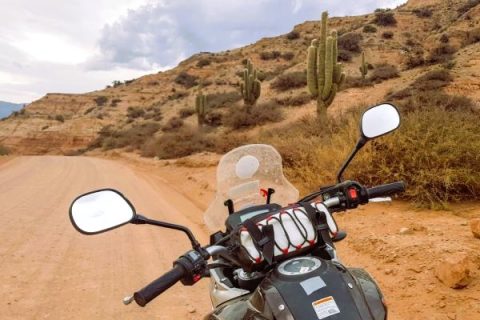China Motorbike Journey: From the Guge Kingdom to the Border with Nepal
The China motorbike journey from Zada to Zhangmu was one of the most spectacular segments of the entire expedition. After the technically demanding yet breathtaking ride into Zada and our exploration of the legendary ruins of the Guge Kingdom, we continued across Buddhist mountain passes and endless high-altitude plateaus toward the sacred Lake Manasarovar.
We faced extreme conditions — mud, washboard roads, landslides, and brutal descents. Along the way, we visited the monasteries of Nartang, Gangchen, and Sakya, and then — through Lhasa and Gyantse — reached Old Tingri, where we finally caught sight of Mount Everest. The last leg led us through a tropical valley to the border town of Zhangmu, marking the end of the Tibetan stage of our incredible adventure.
China Motorbike Journey – Toward Zada and the Guge Kingdom
After a rest day in Ali, we were refreshed and ready to continue. Jurek replaced the voltage regulator in my motorcycle, which had unfortunately failed — it turned out to be the root cause of all the previous engine trouble.
That day’s ride was relatively short: just 210 kilometers. Our destination was the town of Zada, located near the ruins of the ancient Guge Kingdom. Zada lies about 150 km south of the main east-west highway that cuts across the Tibetan Plateau.
The first 60 kilometers out of Ali were smooth — fresh asphalt winding its way steadily uphill. Despite the elevation gain, the good road surface made the ride easy. We passed through a wide, green valley. By Tibetan standards, the views were modest — perhaps we were already spoiled by the jaw-dropping scenery we’d seen so far.
After 60 kilometers, we turned onto a side road — and immediately encountered a wide, turbulent river. From the tire tracks left by jeeps, it was clear that the water was too wild to cross directly — the current was just too strong. We had to search for another route, navigating over high, rocky embankments along the river. It took some effort — the rocks were large and treacherous — but thankfully, the actual water crossing turned out to be easy.
The Guge Kingdom – A Lost Civilization of Tibet
The Guge Kingdom flourished in western Tibet from the 10th to the 17th century. It emerged after the collapse of the Tibetan Empire and was founded by Prince Yeshe-Ö. The kingdom’s capital was Tsaparang — a cliff-side city with palaces and temples, now reduced to awe-inspiring ruins.
Guge was a major center of Tantric Buddhism, renowned for its unique wall paintings and sacred art. It eventually fell after invasions from neighboring Ladakh. Today, the ruins of Guge captivate travelers with their mystery and mystical aura.
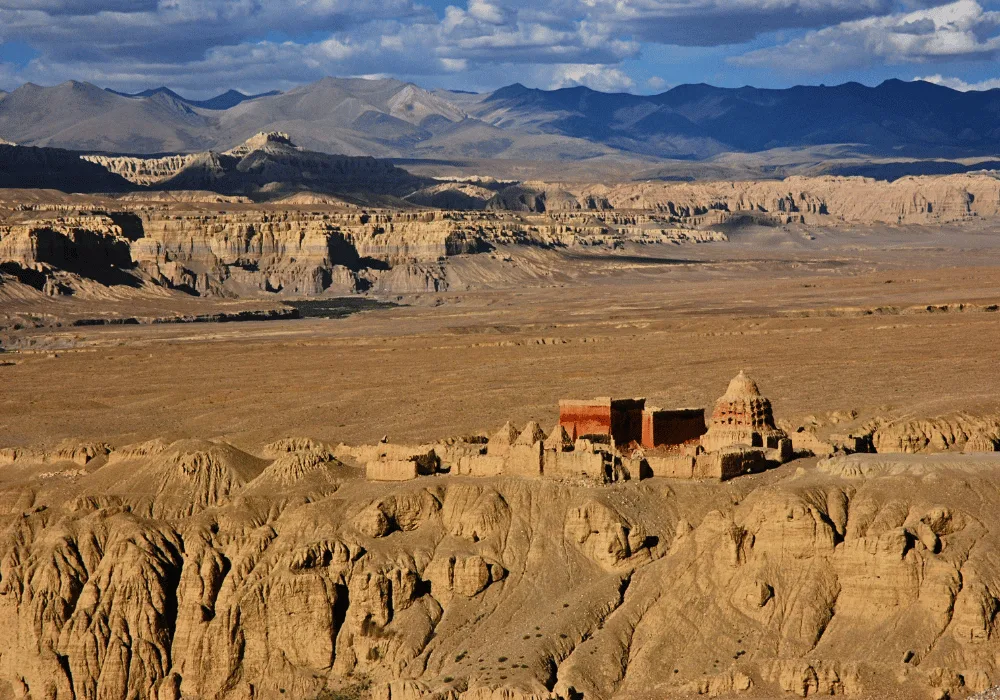
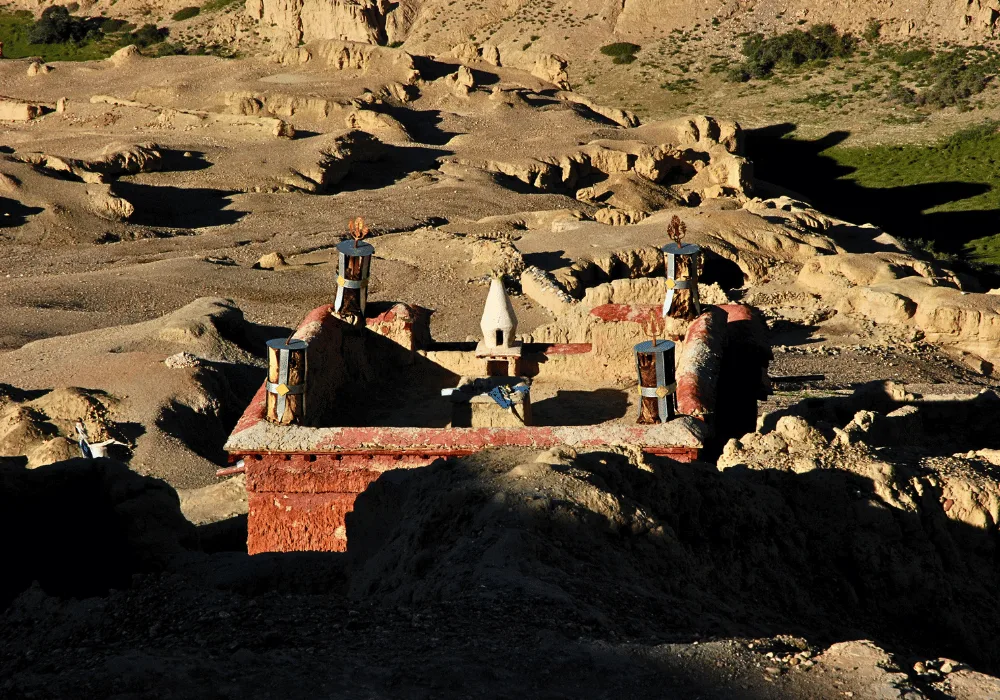

Mountain Passes, Eagles, and a Buddhist Atmosphere
Right after the river crossing, the road turned into winding gravel switchbacks. A few turns later — another surprise: yet another river, this time deeper and with a sandy bottom. The locals signaled that we could make it — and we did.
Immediately after, the track climbed sharply. For long stretches, we rode in first gear. After a long and grueling ascent, we reached the first of four mountain passes — at 5,300 meters above sea level. At the summit, we were greeted by prayer flags and stone stupas. It was our first clear encounter with Buddhist symbolism — in Xinjiang, Islam had been the dominant faith.
After a short break to rest the bikes, we continued. First came a descent into a valley, then another climb above 5,000 meters. Along the way, we had to overtake heavy trucks — not easy when the road is barely wide enough for one vehicle, even on a motorcycle.
Soon, a convoy of SUVs with sirens came speeding toward us — clearly carrying VIPs. They didn’t slow down for a second. We had to swerve off the track and take cover in a roadside hollow to avoid being pushed off the edge!
China Motorbike Journey – Racing Across the Plateau and a Lunar Valley
The second pass proved even tougher, despite being only slightly lower in elevation than the first. The ascent was harsh — a narrow path with sharp drop-offs. At the top: more prayer flags, more stupas… and several majestic eagles.
For several minutes, the eagles flew just ahead of us, gliding above the winding road — an unforgettable sight. The next two passes were easier, with less steep terrain. Most of the time we followed a river, and the landscape became more predictable.
The final stretch before reaching Zada took us across a desert plateau. We thought the hardest part was behind us — we were wrong. The road was in terrible shape. It looked like a sand plain with only faint tire tracks, torn up by construction equipment.
A new road is being built here, and in a few years, it’ll probably be smooth asphalt. But for now, we had to fight through extremely rough terrain. After just 20 minutes, we were already exhausted — and still had over 50 kilometers to go.
Sunset Over the Ruins of Guge
Eventually, the landscape began to change. We entered a stunning lunar-like valley. Sandy patches appeared every few hundred meters, but in between, the road was more compact and rideable. Finally, we could reach for our cameras and capture the moment.
The views were so breathtaking that we kept stopping for short photo sessions. We reached Zada around 5:00 p.m. After a quick look at the local monastery — one of the few that survived the Cultural Revolution — we took a short rest at the hotel.
Soon after, we set off for the final stretch: 19 kilometers to the ruins of the Guge Kingdom. We wanted to make it before sunset — and we timed it perfectly. The golden evening light gave the ancient ruins a magical glow.
There wasn’t a single tourist in sight — no surprise, considering the brutal condition of the road. The Guge ruins, the eagles, the high passes, the lunar valley — all of it made this day one of the highlights of our entire adventure.
Dust, Switchbacks and Roadwork – The Toughest Leg of the Journey
The evening before, we had been utterly exhausted. After returning from the Guge Kingdom, we collapsed into bed and fell asleep instantly. In the morning, we had to rise early. We’d heard that the road ahead was under construction again — something that always slows everything down.
We thought the hardest part was behind us. We calmly loaded the bikes and set off toward the legendary Lake Manasarovar. But very quickly, it became clear: this day was going to be even tougher.
Right outside of town, we hit steep switchbacks — completely torn apart by excavators. The road had turned into a massive construction site: sand, gravel, rocks, and huge piles of building materials. On top of that — trucks, bulldozers, diggers, and crews of workers.
What we had considered “difficult” the day before now seemed laughably easy. Sand dust invaded every crack and corner. Visibility dropped to zero at times. Riding second in the column, I ended up inhaling more than my fair share of dust. My eyes were red as a rabbit’s.
Lake Manasarovar – Sacred Waters of Tibet
Lake Manasarovar is one of the highest freshwater lakes in the world — sitting at over 4,500 meters above sea level in southwestern Tibet. Surrounded by snow-capped Himalayan peaks, it lies at the foot of Mount Kailash, a sacred mountain revered by Hindus, Buddhists, Jains, and followers of Bön.
For pilgrims, Manasarovar is a place of soul purification. According to local beliefs, bathing in its waters and walking around the lake on foot brings spiritual renewal and the cleansing of sins. Its calm surface, turquoise color, and mystical ambiance make it one of the most spiritually moving places in all of Tibet.
Endless Sand and a Struggle With the Bikes
Overtaking blindly, on heaps of sand and along cliffs — that’s something I’ll never forget. The motorcycles handled it bravely, but they took a serious beating that day. On steep, sandy climbs, they often choked or even stalled.
Jurek’s bike in particular was struggling — his Africa Twin lacked power. Every uphill stretch was a fight, and the kilometers crept forward painfully slow. After just 20 kilometers, we were already exhausted. Yet more than 200 kilometers still lay ahead — and only 100 of them were paved.
After leaving the lunar valley, the road improved slightly. The construction zone remained, but it wasn’t as sandy. However, the climbs to the next two passes — both over 5,000 meters — were brutally difficult.
The reward for all that effort came in the form of an incredible view of Nanda Devi. It was one of the few moments that day when, despite the dust, we pulled out the camera. We climbed onto a rocky slope, away from the choking air, to take photos in safer, clearer conditions.
Nanda Devi – Sacred Peak of India and the Country’s Second Highest Mountain
Nanda Devi is a majestic Himalayan peak located in the Indian state of Uttarakhand. Rising to 7,816 meters (25,643 ft), it is India’s second-highest mountain after Kangchenjunga, and the tallest peak located entirely within Indian territory.
The mountain holds deep religious significance — worshipped as the embodiment of the goddess Nanda (a form of Parvati). Annual pilgrimages and rituals in its vicinity have been practiced for centuries. Due to its remote and rugged terrain, the area is protected as Nanda Devi National Park, a UNESCO World Heritage Site since 1988. It remains one of the most inaccessible and wild corners of the Himalayas — a place steeped in mystery and spiritual power.
Meeting Kailash and Overnight at Lake Manasarovar
The descent from the day’s fourth mountain pass was just as intense as the climb had been. After 120 kilometers of off-road riding, we were completely drained. It took us seven hours to cover that distance, with only a brief 30-minute break for food.
When we finally hit asphalt, we let out a collective sigh of relief. About an hour later, we caught our first glimpse of the sacred Mount Kailash. Bathed in the glow of the setting sun, it looked otherworldly. We took a few photos and built two small stupas — one in honor of Łucja and Marek, and another for the continued success of our journey.
By evening, we arrived in Horchu, a small town on the shores of Lake Manasarovar. The last 60 kilometers were gravel, but after what we’d already been through, it felt like a paved expressway.
Like most towns in this region, Horchu was rather bleak and dusty. We slumped into plastic chairs, ordered bowls of Tibetan noodles, and passed out shortly afterward. Even those bland noodles tasted better than ever — after a day like that, everything feels like a gift.
Kailash – The Sacred Mountain of Four Religions
Mount Kailash, rising 6,638 meters above sea level in western Tibet, is one of the most sacred sites on Earth. Revered by Hindus, Buddhists, Jains, and followers of the Bön religion, it is seen as the cosmic center of the universe and the seat of the divine.
For Hindus, it is the home of Lord Shiva. For Buddhists, it represents the axis mundi and is linked to the Buddha of Time. No one has ever summited Kailash, and it is considered forbidden to climb. Instead, pilgrims from around the world circle the mountain on foot — a ritual called the kora, believed to bring spiritual purification and the washing away of sins.
China Motorbike Journey – Mud, Corrugation and Spiritual Tibet
From Lake Manasarovar, we continued along the main road toward Lhasa. The climbs to the passes were no longer as demanding. The wide valley we traveled through was mostly green — though, of course, without trees. To our right, the main Himalayan range stretched across the horizon, and along the way we passed several emerald-colored lakes. It was scenic, though not as wild or awe-inspiring as the days before.
The road was still under construction, but at a more advanced stage. The sand had given way to gravel, although in places where the machinery was working, we still encountered mud and detours. But the worst part was the washboard — compacted gravel torn up by trucks. The vibration was so intense at times that even at 90 km/h, riding was unbearable. We often veered off the main track, navigating through open terrain beside it.
The first larger town was Paryang — 200 km from the lake. We had planned to stay there for the night, but it was still early, and the town itself didn’t inspire us. Towns in western Tibet are far from the romantic image many people have of the region — there are no picturesque monasteries, no robed monks, and little trace of spiritual atmosphere. Ruined temples, a few stupas, and traditional clothing worn by some locals were the only echoes of the past. Dirt and disorder dominated the scene.
A Difficult Road to Saga and a Battle With Mud
Beyond Paryang, the landscape turned increasingly desert-like. We feared another struggle with deep sand, but this time it was better. Most of the dunes stopped at the road’s edge, allowing us to finally focus on the scenery instead of just fighting the terrain.
We had planned to reach Saga for the night — the last of the bleak towns along the route. About 60 km before town, my motorcycle broke down again. A loose cable was to blame, despite surviving the entire day of washboard roads. Jurek quickly fixed it, and we were back on track.
Unfortunately, we rode the last hour in the dark. Tibetan drivers rarely use headlights, and spotting obstacles on the rocky road was nearly impossible.
We arrived completely exhausted. After 450 kilometers of bone-rattling corrugation and riding in darkness, we were drained. Shoulder pain from standing on the pegs had become a constant companion. Saga, unsurprisingly, was yet another dusty, grim settlement with no trace of spiritual ambiance. In the morning, Jurek soldered the cable, and we set off toward central Tibet, hopeful for a different experience.
Towards Shigatse – The Toughest Off-Road and a Moment of Spiritual Clarity
We started out on the main road. The first 60 kilometers were still rough and corrugated, but then — joy! — asphalt appeared. The joy was short-lived, however, as the road soon turned back into a muddy construction site.
Following recent rainfall, we constantly crossed streams and drainage ditches. The entire route became one massive detour. Only short sections were hardened.
The most difficult stretch was a brutal 70 kilometers riding literally through a river. The road was being built along a valley slope, but it was inaccessible. All vehicles — including buses — moved through the stony riverbed. Although partially dry, we kept running into muddy patches and standing water. We saw many trucks stuck deep in the mud — and no one was pulling them out. We ourselves got bogged down twice, knee-deep in muck. We looked like walking wrecks.
After this demanding rally, we made it to Lhaze, where we had to wait at a military checkpoint. Only 120 kilometers of brand-new asphalt separated us from Shigatse. Though it was late and raining, we decided to push on.
Shigatse was the first truly Buddhist city of our journey. That evening, we arrived at a hotel — with a shower! In the morning, we visited the famous monastery. Finally, we had reached the spiritual Tibet: monks, temples, colors, and the hum of prayer. Despite the presence of tourists and a slightly diluted atmosphere, we felt that this — this moment — was what the China motorbike journey was really about.
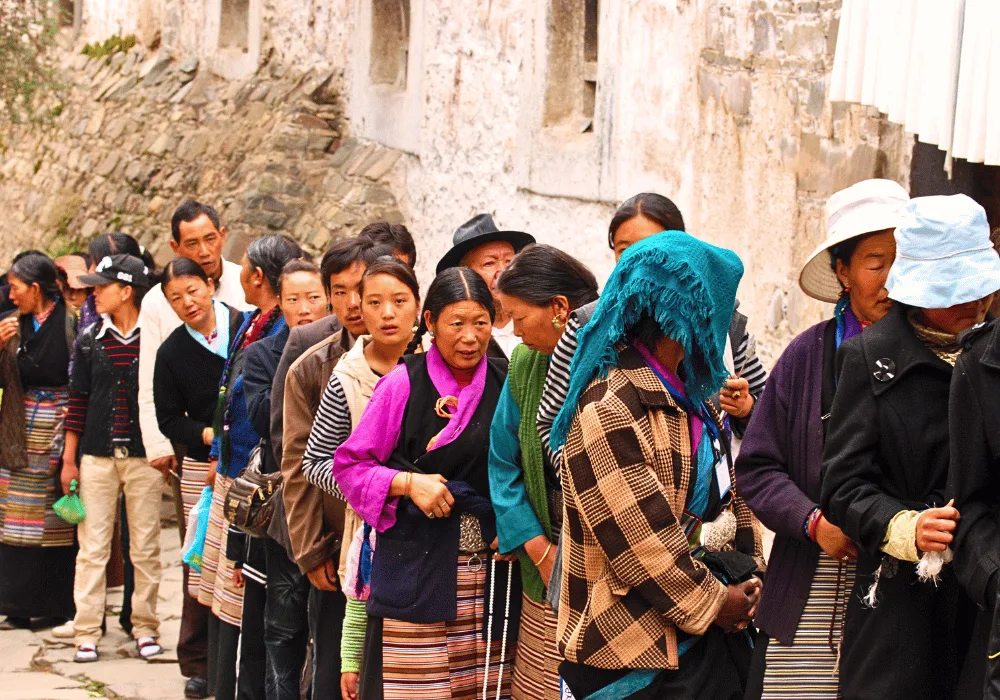
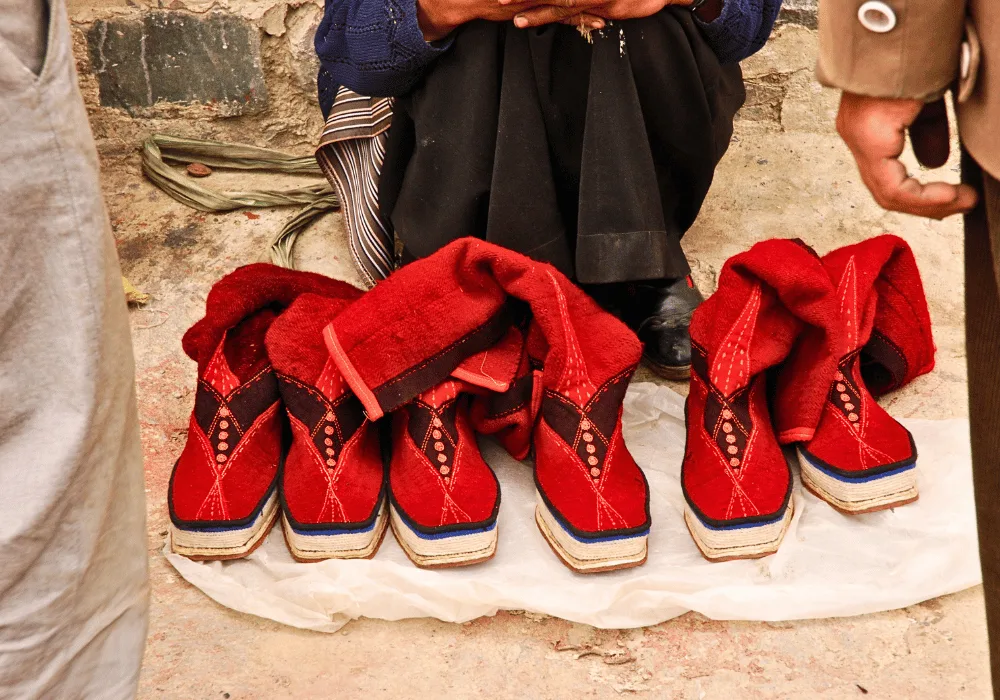
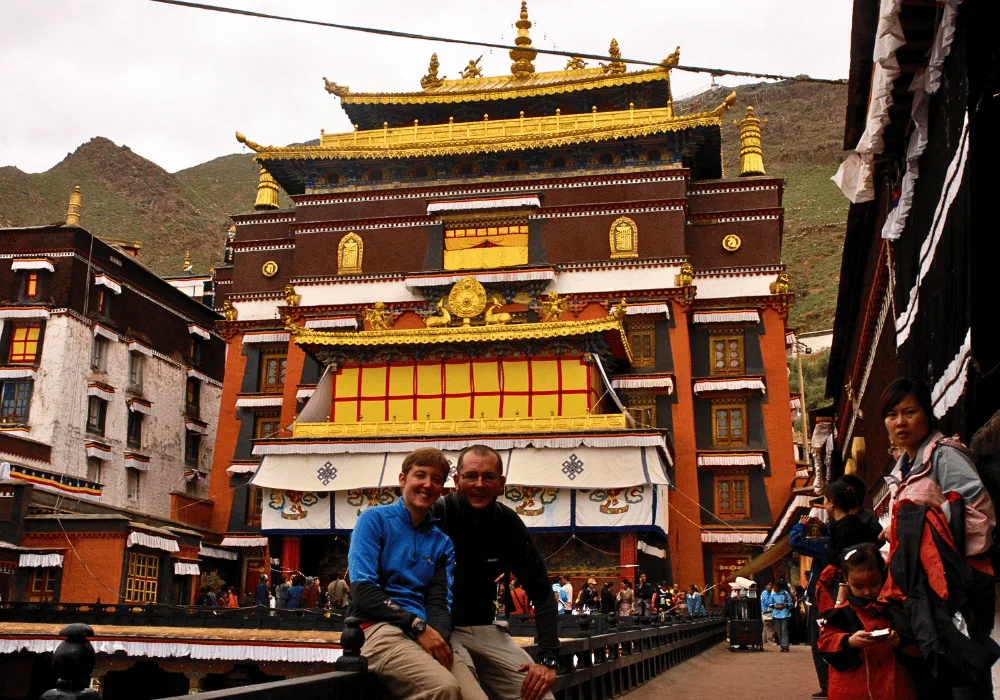
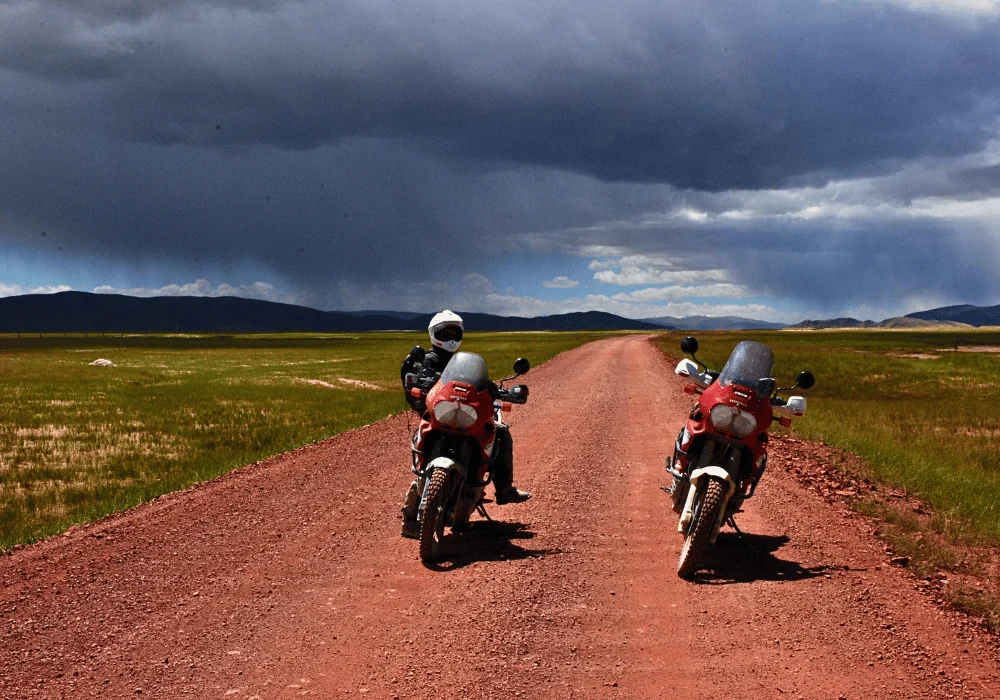
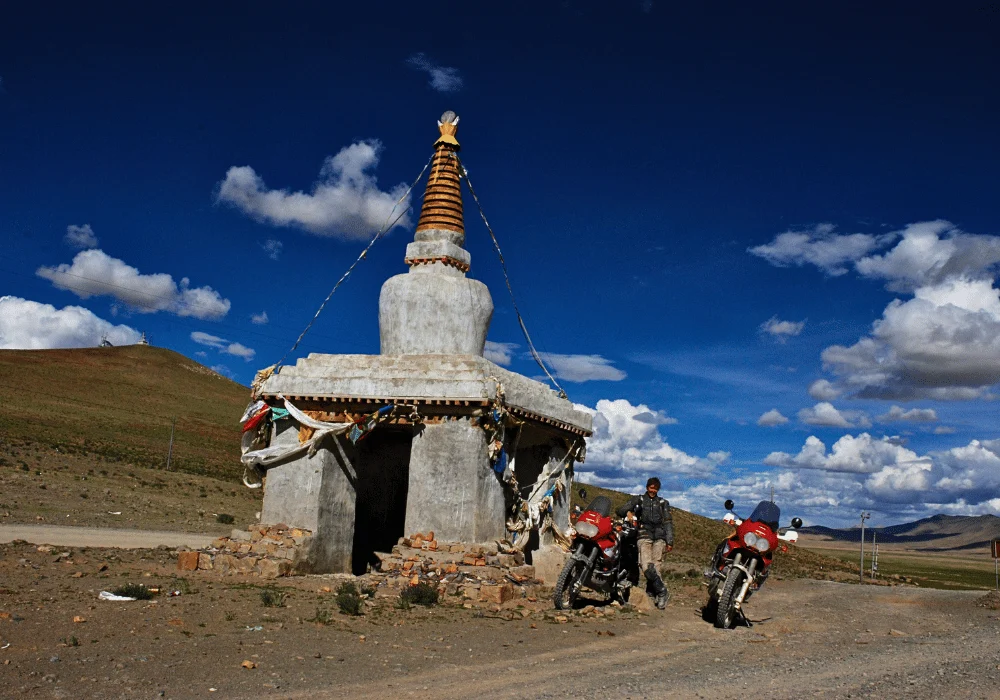
Shigatse – Spiritual Capital of Western Tibet
Shigatse is the second-largest city in Tibet, located at around 3,900 meters above sea level on the banks of the Yarlung Tsangpo River. It is best known for the magnificent Tashilhunpo Monastery — the traditional seat of the Panchen Lama, the second-highest figure in Tibetan Buddhism.
The city blends modern life with spirituality — on the streets, one sees both monks in crimson robes and typical Chinese-style buildings. Shigatse is a key pilgrimage site and an important stop for travelers exploring Tibet’s sacred landscape.
China Motorbike Journey – A Peaceful Road to Tibet’s Spiritual Capital
After several intense days of riding through rugged terrain, the day spent exploring the monastery in Shigatse felt like a true moment of rest. On the afternoon of August 4th, we set off toward Lhasa. This time, the route was calm — entirely paved, following a valley between gentle hills. We rode alongside convoys of jeeps filled with tourists.
With each passing kilometer, traffic became heavier. Just before Lhasa, the road grew noticeably congested. Entering the city, we immediately sensed its scale. Lhasa is a large, bustling metropolis full of cars, Chinese citizens, tourists — and, inevitably, the ever-present Chinese military enforcing order.
Without wasting time, we headed straight for the Potala Palace — the legendary residence of the Dalai Lama. And it truly lived up to its reputation. It’s not overhyped. When you see it for the first time, you stop in your tracks. The monumental structure towers over the city and dominates the skyline.
The experience is slightly marred by the presence of Chinese patrols and a large monument to China placed directly in front of the palace’s entrance — a clear symbol of control and propaganda. Still, the Potala captivates. It’s impossible to look away.
Riding a motorcycle through Lhasa felt a lot like navigating Iranian cities — total chaos. After weeks spent in remote valleys and vast desolate landscapes, it took a serious mental shift to adjust to the urban jungle. Traffic, honking, and a complete disregard for rules — you had to stay sharp.
Potala – The Legendary Palace of the Dalai Lama
The Potala Palace in Lhasa is one of the most iconic landmarks in all of Tibet and a powerful symbol of Tibetan Buddhist spirituality. Built atop Marpori Hill, the Potala served for centuries as the winter residence of the Dalai Lamas and the seat of the Tibetan government.
This monumental complex, now a UNESCO World Heritage Site, combines the functions of monastery, palace, and mausoleum. It houses countless chapels, corridors, prayer halls, and the gold-covered tombs of former Dalai Lamas. The architecture is as breathtaking as its history — the red-and-white silhouette rises above 3,700 meters (12,100 ft) and dominates the Lhasa skyline.
The Potala is a must-see for any journey through Tibet and one of the most important pilgrimage destinations for Buddhists around the world.
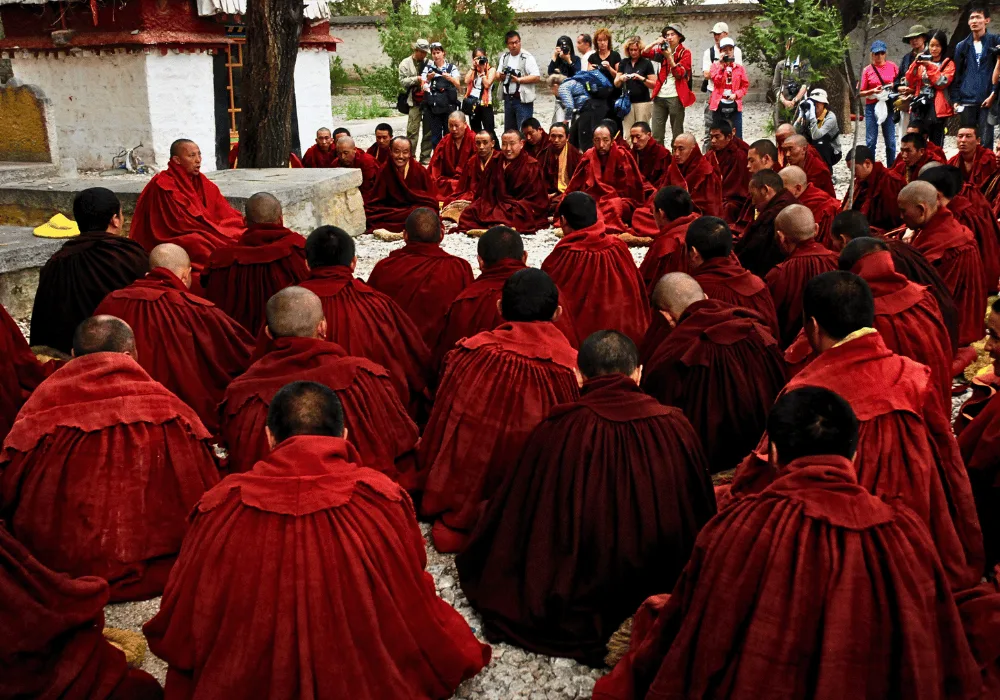
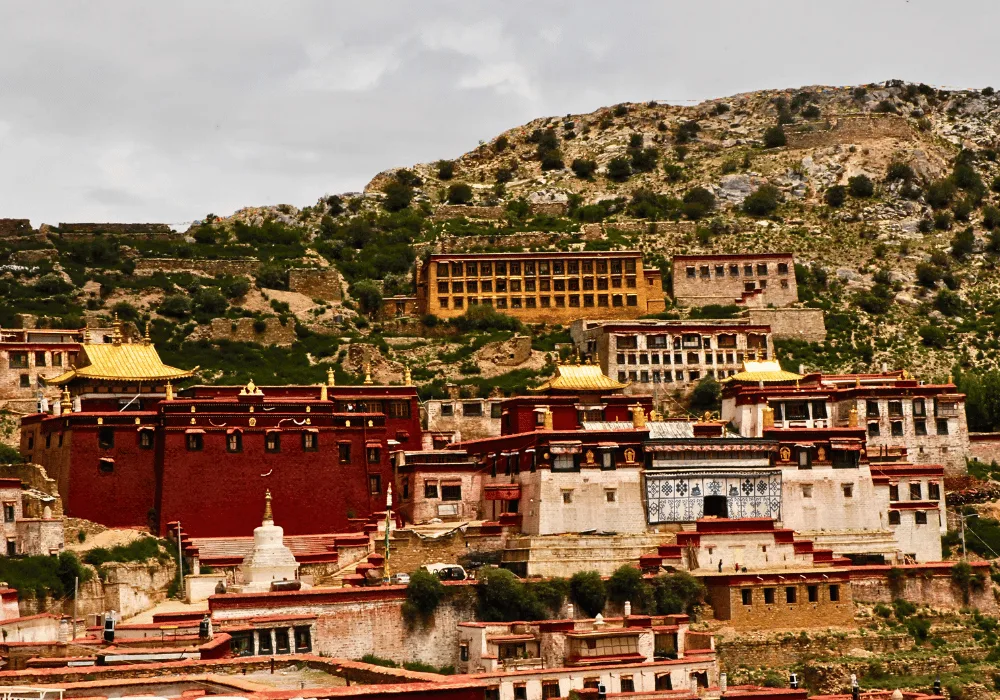
Well-Deserved Rest in Lhasa
After arriving at our small hotel, we parked the bikes for good. For the next three days, we moved only on foot. Both we and our machines were in desperate need of rest. After all, our gear had taken a serious beating — and we were just as worn out from the tough last stages of the ride.
Lhasa captivated us with its atmosphere. We had finally arrived in a place where the true Buddhist spirit of Tibet could be felt in the air. As we wandered through the city, we absorbed everything — the colors, the incense, the temples, the monks, and the ever-present prayers.
Over the course of several days, we managed to visit Lhasa’s most important landmarks, including the Ganden Monastery just outside the city. These places will remain etched in our memories. We were fully aware that we might never return here. That made us all the more eager to savor every moment in Tibet’s spiritual capital.
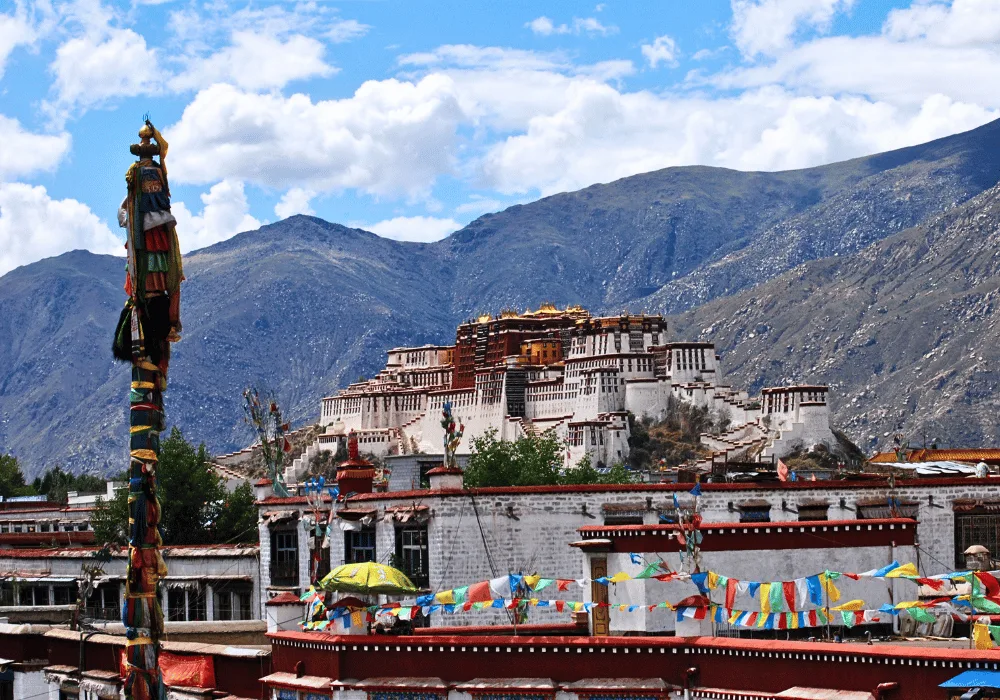
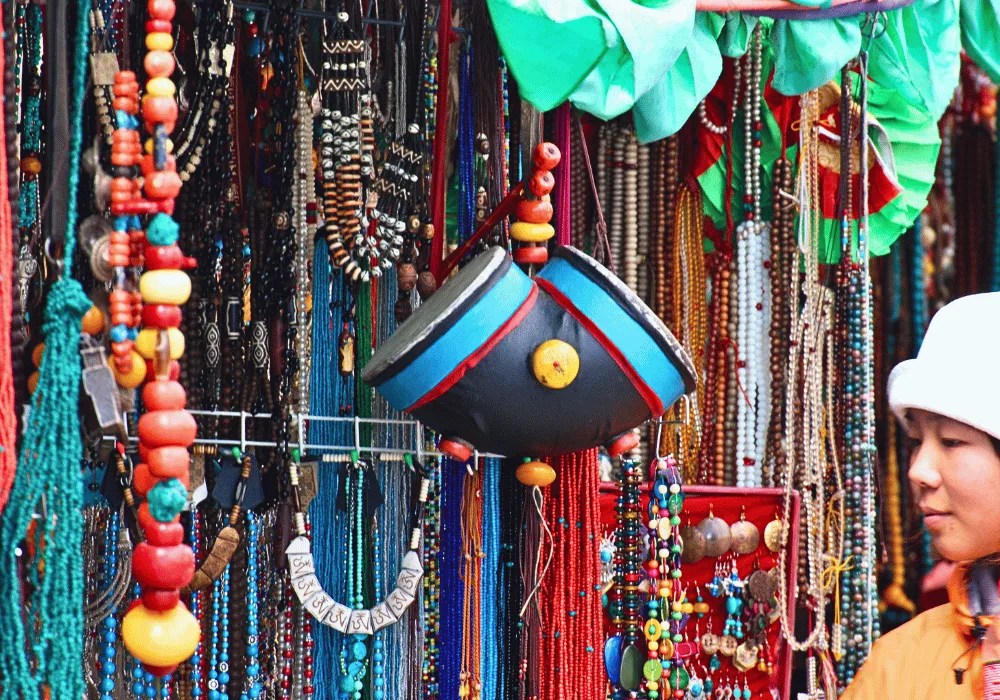
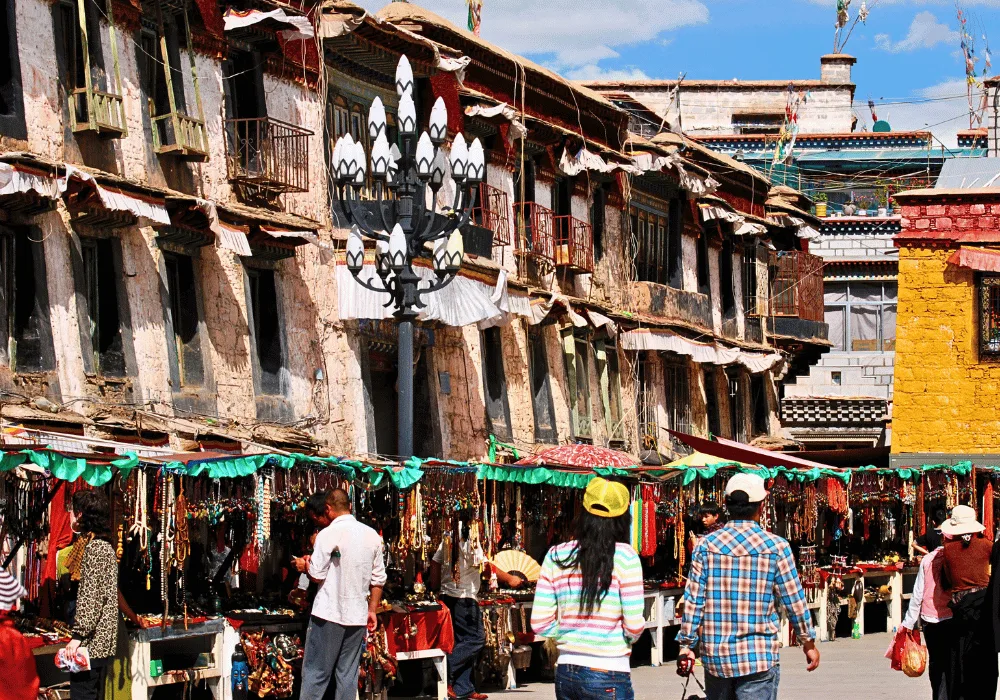
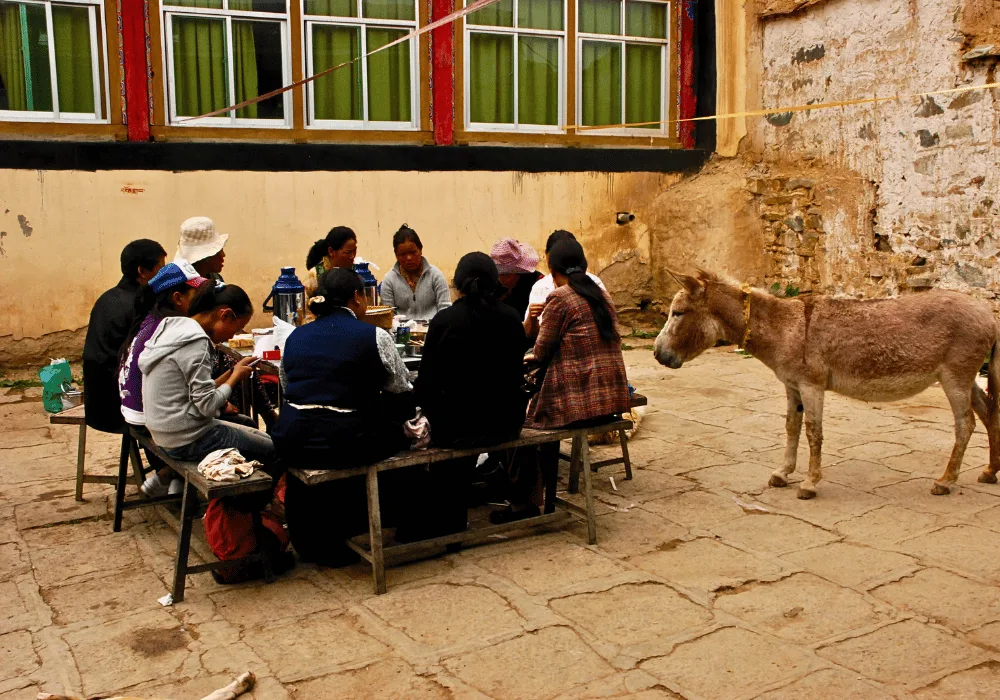
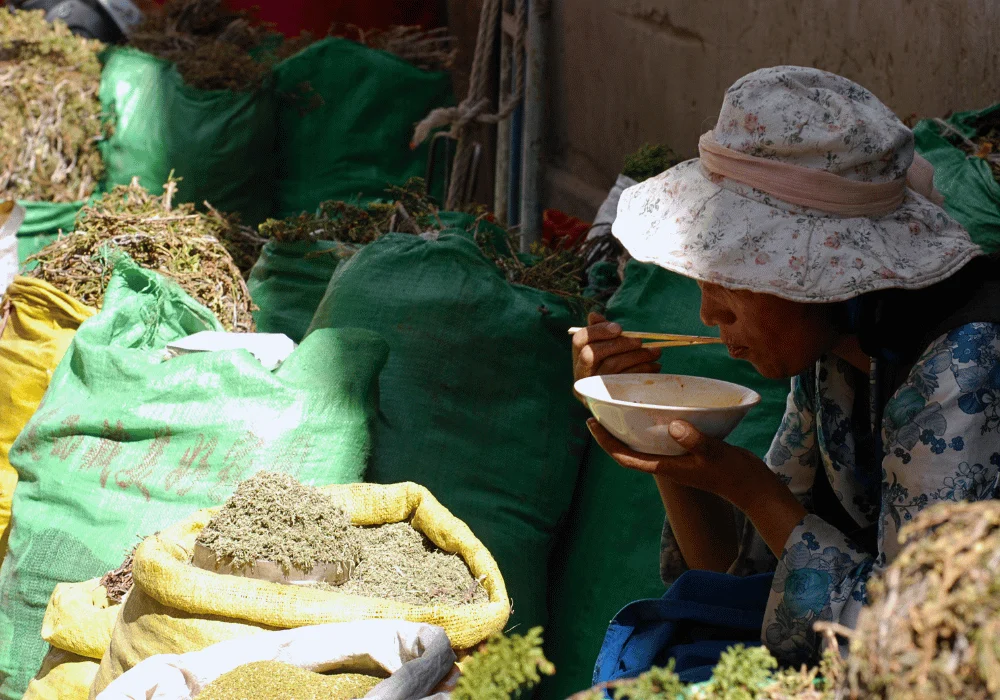
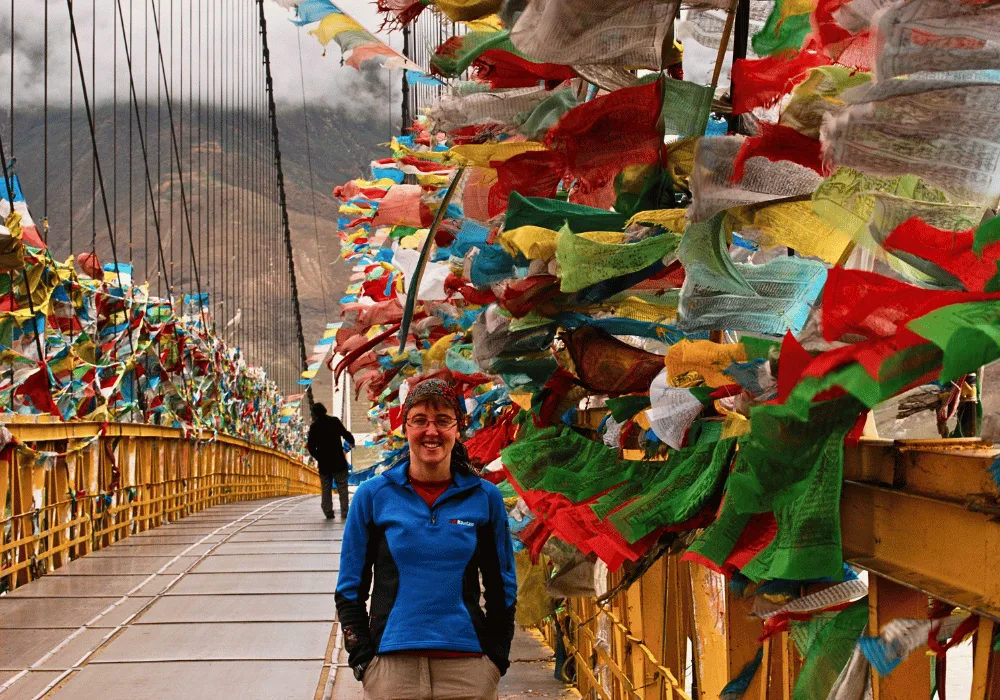
Lhasa – The Spiritual Heart of Tibet
Lhasa is the heart of Tibet — its spiritual, cultural, and historical capital. Perched at an altitude of around 3,650 meters, it has drawn pilgrims, travelers, and lovers of Buddhist culture for centuries.
Here stands the iconic Potala Palace — the former residence of the Dalai Lama — and the sacred Jokhang Temple, the holiest site in Tibetan Buddhism. Lhasa combines deep-rooted spirituality with the pace of a modern Chinese city.
While Tibet is evolving under the influence of modernity, Lhasa retains its distinctive essence. Colorful prayer flags flutter in the wind, pilgrims circumambulate ancient temples, the scent of incense fills the air, and whispered prayers echo through narrow alleys — all forming the unmatched atmosphere of this sacred city.
Ganden Monastery – Cradle of the Gelug School
Ganden Monastery is one of the three main monasteries of the Gelug school — the most influential tradition in Tibetan Buddhism, founded by Je Tsongkhapa in the 14th century. Located about 40 kilometers east of Lhasa at an altitude of over 4,300 meters, the monastery stretches across a steep hillside with sweeping views over the Kyichu Valley.
Ganden was the first monastery established by Tsongkhapa and quickly became one of Tibet’s primary centers for learning and spiritual practice. Although it suffered severe damage during the Cultural Revolution, it has since been partially rebuilt and once again attracts both pilgrims and travelers. The monastery radiates peace, spiritual depth, and the enduring vitality of Tibetan Buddhist tradition.
Farewell to Lhasa in the Pouring Rain
After a few quieter days in Lhasa — filled with spiritual and cultural experiences — it was time to move on. We felt a twinge of sadness leaving this extraordinary city, but at the same time, we were growing tired of the urban noise, the chaos, and the ever-present oversight of Chinese authorities.
The morning of our departure greeted us with rain and thunderstorms. It was immediately clear that the weather would be against us all day. We suited up in our rain gear and continued our China motorbike journey, this time heading gradually toward the border with Nepal.
The Kamba La and Karo La Passes
Instead of taking the main Lhasa–Shigatse highway, we chose a longer but more scenic route through two mountain passes: Kamba La (4,700 m) and Karo La (5,100 m). The road wound along the stunning Yamdrok Lake, its turquoise waters creating a striking contrast against the grey stormy skies.
Although the road was fully paved, the intensity of tourist traffic surprised us. Buses and SUVs full of Chinese tourists made riding difficult and frustrating. After the solitude of wild western Tibet and our previous stages of the trip, we had grown unaccustomed to crowds — and we didn’t miss them at all. That said, some places along this route, like Gyantse, were definitely worth the detour.
Gyantse – Between Stupas and Stillness
We reached Gyantse just ahead of the tourist wave. That gave us a rare moment of peace to talk with monks and absorb the atmosphere of the place. The monks here were far more open and kind than those we’d encountered in Lhasa. There was a sense of sincerity and quiet dignity in their presence.
We climbed — awkwardly, in our stiff motorbike boots — to the top of the seven-level stupa. Our legs ached terribly, but the panoramic view at the summit made the effort worth it. Gyantse is a charming and colorful place, and definitely a highlight of any journey through Tibet. While it may not be one of those “hidden gems” we tend to favor most, it left us with warm and lasting memories.
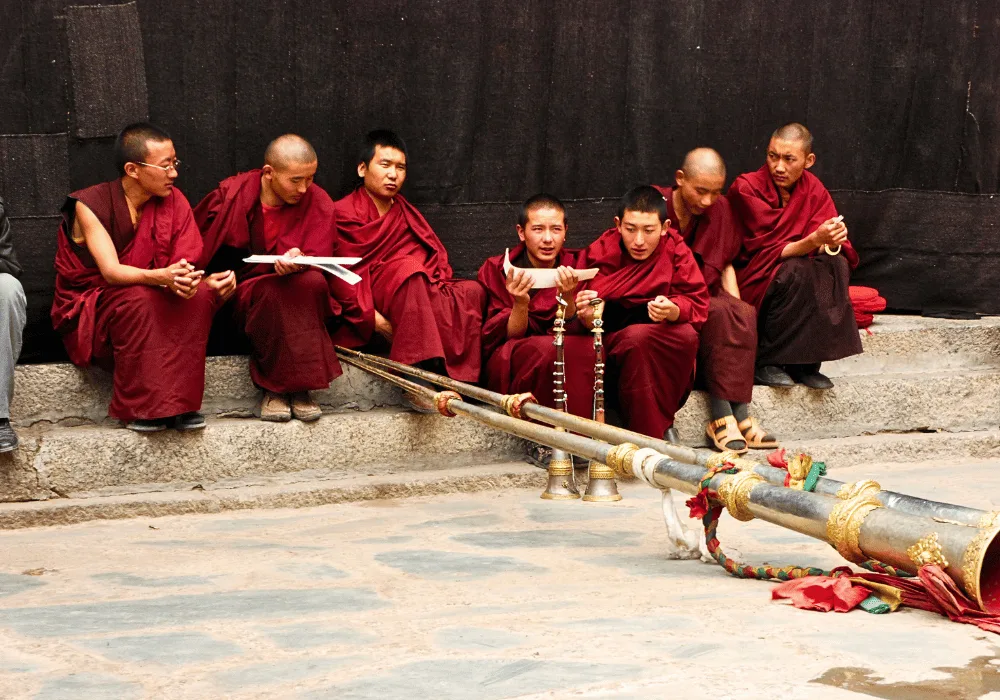
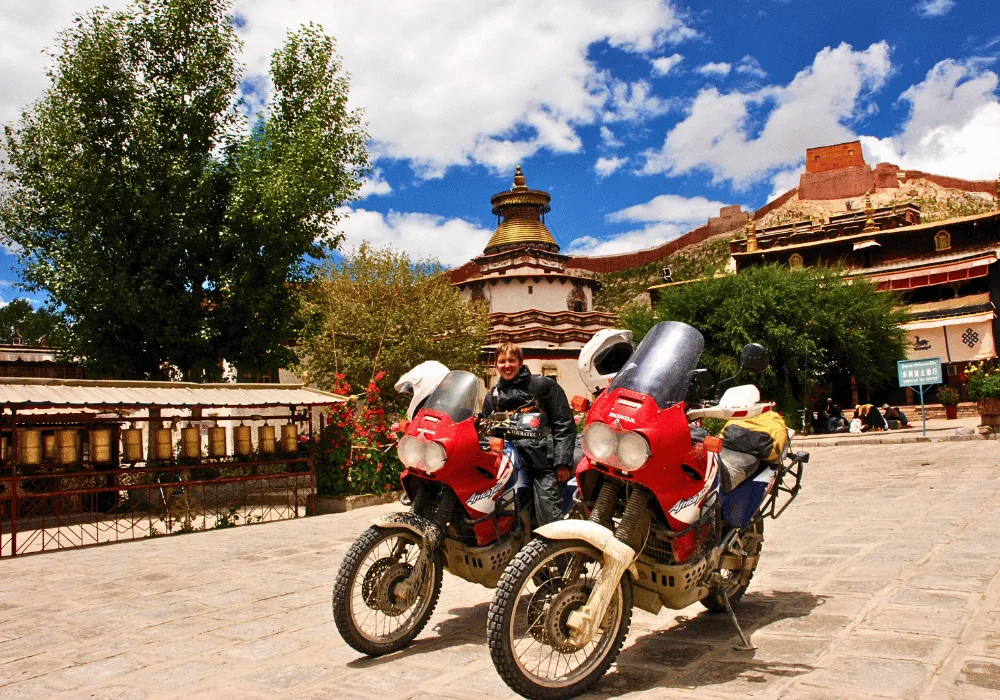
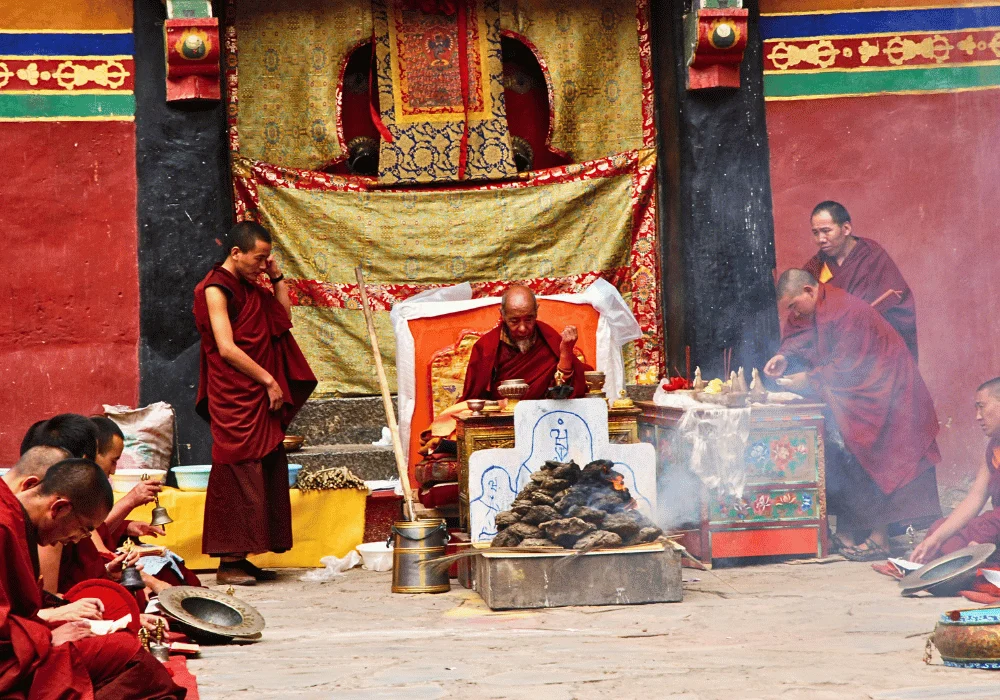
Gyantse – A Tibetan Gem of Monasteries and Stupas
Gyantse is one of the most fascinating and picturesque towns in Tibet, located between Lhasa and Shigatse. It is best known for the impressive Kumbum Stupa — one of the largest and most architecturally complex stupas in all of Tibet. Adjacent to it stands the Pelkhor Choede Monastery, which uniquely blends multiple Tibetan Buddhist schools under one roof.
The town has preserved much of its historical charm and offers a rare glimpse into the spirit of old Tibet, despite the growing number of visitors. Gyantse is also home to the imposing Dzong Fortress, perched high above the town — once a defensive stronghold. It’s one of the few places where tradition, history, breathtaking landscape, and living religion meet in harmony.
China Motorbike Journey – Discovering Hidden Monasteries Around Shigatse
This was one of the longest — and most beautiful — days of our journey through Tibet. From the entire central region, this day stood out as our favorite. In the morning, we reached the small and little-known Nartang Monastery, just 10 kilometers from Shigatse.
Despite its convenient location, Nartang attracts very few tourists — and we can’t understand why. It instantly became my favorite monastery in Tibet. Small but well preserved, it had all the hallmarks of traditional Buddhist architecture. The monks were warm, open, and — most importantly — not fatigued by tourist crowds.
We were free to chat, ask politically sensitive questions, and take photos without being charged for every shutter click. Nartang’s biggest treasure is its ancient woodblock texts — raised wooden plates used for printing sacred scriptures. Thanks to the bravery of locals, some of these blocks survived the Cultural Revolution.
Gangchen and Sakya Monasteries – Off the Beaten Path and Deep in Spirit
Our next stop was Gangchen Monastery, also devoid of tourists despite its location near the main road. The atmosphere there mirrored Nartang — peaceful and deeply spiritual. Silence, no mobile phones, a sense of presence and reverence — it was exactly what we had envisioned when dreaming of Tibet.
After visiting both monasteries, we felt truly happy. It finally felt like we had reached the heart of Buddhist Tibet. Even the rain couldn’t spoil the moment. The next 150 kilometers took us along a familiar road — one pass at 4,900 meters, and a stretch through villages dotted with traditional Tibetan architecture.
What was new was the Sakya Monastery, with its striking black walls — the only one of its kind in Tibet. Although partially damaged during the Cultural Revolution, it still left a strong impression. We arrived during a rare ceremonial offering ritual.
All the monks had gathered in the courtyard, and an elderly prefect led the prayers. Gifts were tossed into the fire — grasses, yak butter, medicinal herbs. Drums beat, horns blew. At one point, the fire almost ignited the prefect’s table, drawing laughter from the crowd. It was a deeply moving — and unforgettable — experience.
China Motorbike Journey – Approaching the Himalayas and Overnight in Old Tingri
After leaving Sakya, we ventured into unfamiliar territory. We joined the legendary Friendship Highway, the main route leading from Tibet to Nepal. Just after the road split, we had to tackle a high-altitude pass — 5,260 meters above sea level — one of the highest along this route.
At the summit, the weather turned. Rain started falling, followed by a sudden hailstorm. We were genuinely concerned that we might have to descend on frozen pavement. Luckily, we made it across before the road iced over completely. On the other side, conditions improved — the terrain opened into dry, dramatic mountain ranges that reminded us of western Tibet.
In the distance, the Himalayas loomed — but Everest itself was completely shrouded in clouds. We had hoped it would show itself, even briefly. Eventually, we reached Old Tingri, a small outpost with one of the best panoramic views of Mount Everest outside the actual base camp.
It wasn’t until 9:00 p.m., as dusk fell, that the mountain finally revealed itself. Its iconic silhouette stood clear against the sky — a fleeting, powerful moment. The next morning, it was hidden again, but we caught a glimpse of Cho Oyu instead. Still, we felt privileged — during monsoon season, seeing Everest at all is rare. Locals told us it hadn’t been visible for three days straight.
Old Tingri – Tibet’s Gateway to Everest
Old Tingri is a remote, rugged village in western Tibet, situated along the famed Friendship Highway that connects Lhasa with Kathmandu. While the town itself is modest and unassuming, its importance is immense — from here, travelers can enjoy one of the finest views of Mount Everest and nearby Cho Oyu.
Old Tingri also serves as a popular launch point for expeditions to Everest Base Camp. Surrounded by stark, desert-like landscapes and towering Himalayan peaks, the village offers a profound sense of isolation and awe. It’s a place where the spirit of the mountains meets the vastness of the Tibetan Plateau — a raw and powerful intersection of earth and sky.

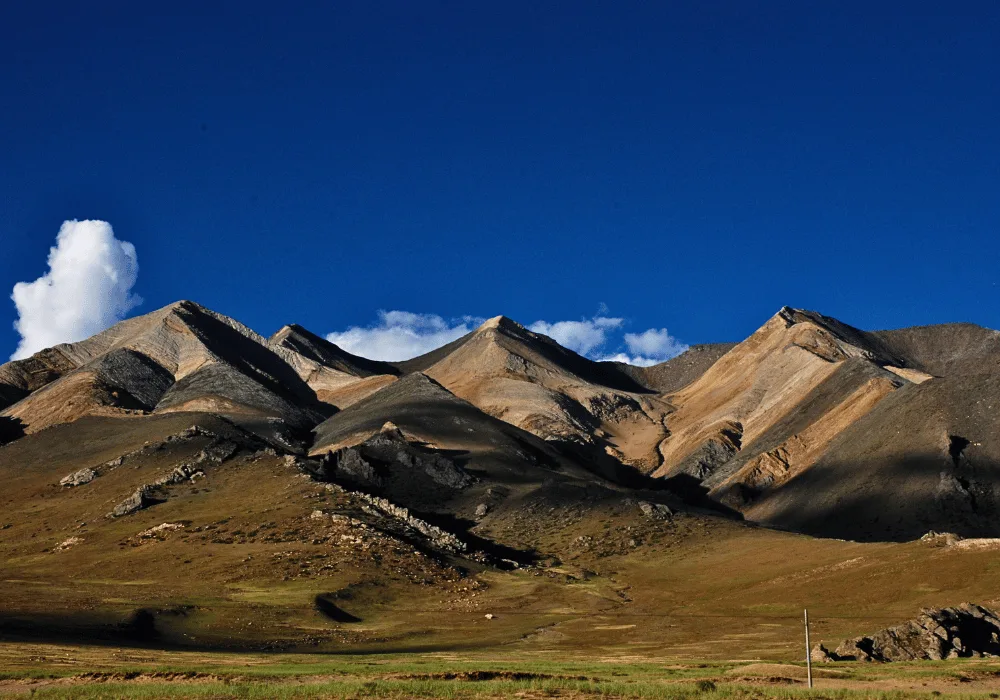
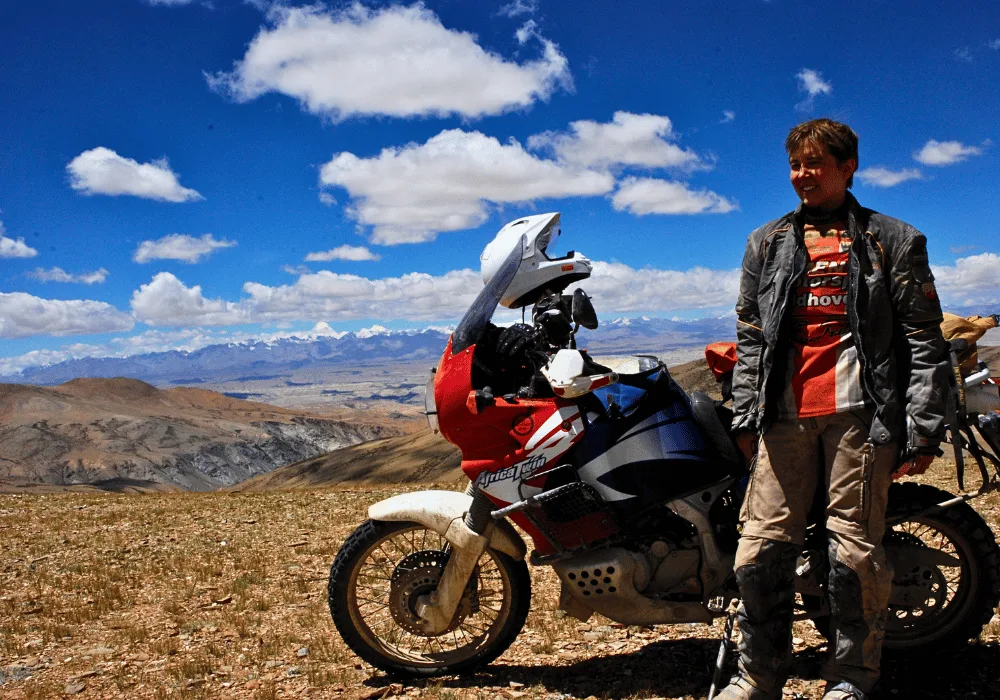
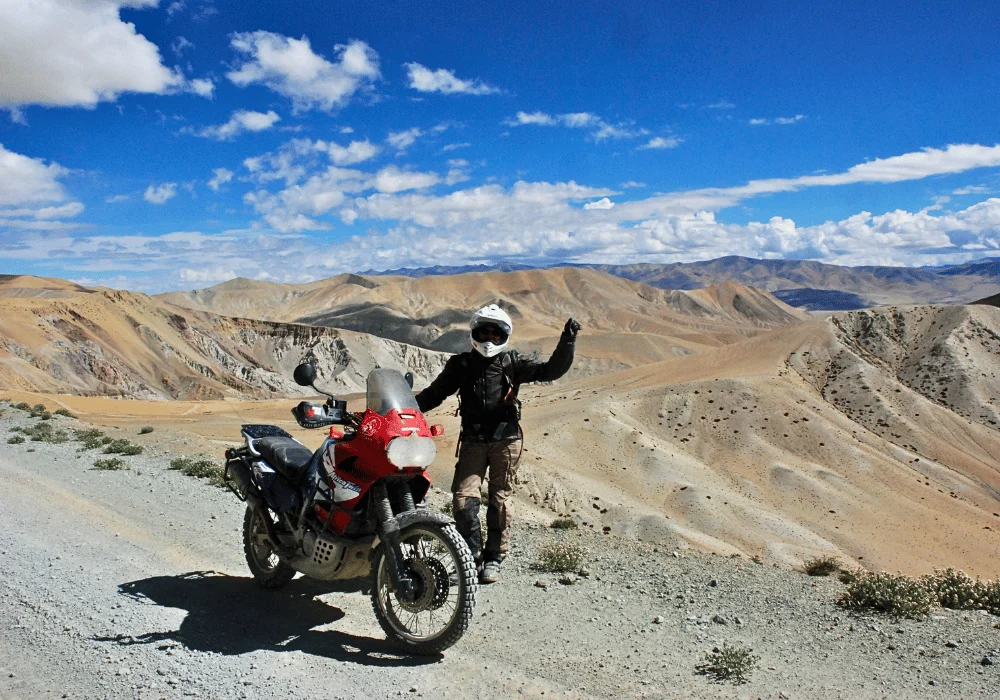
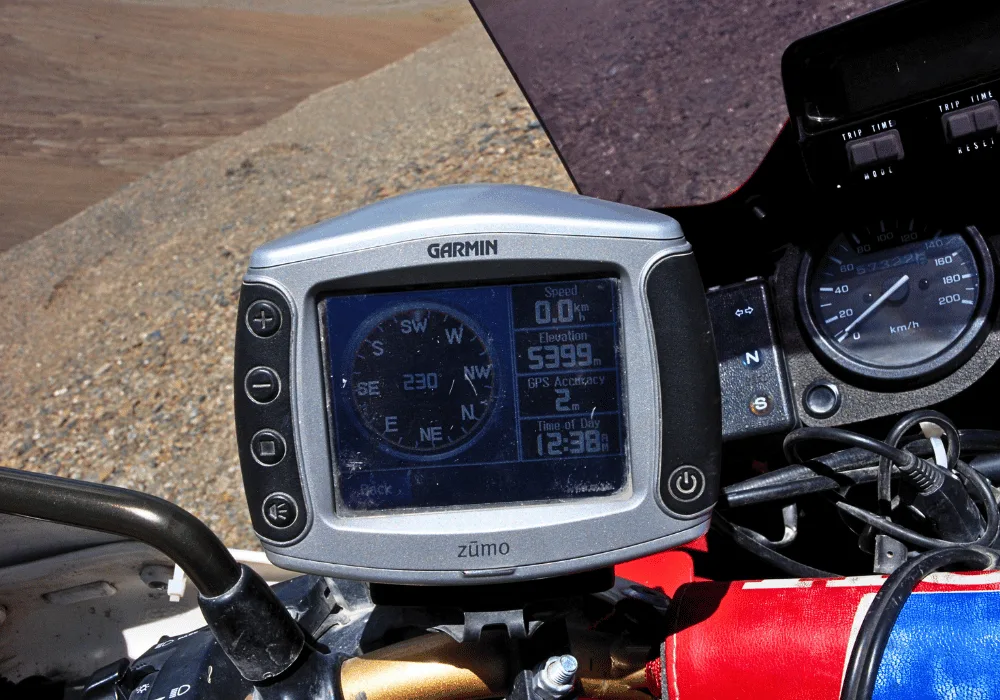
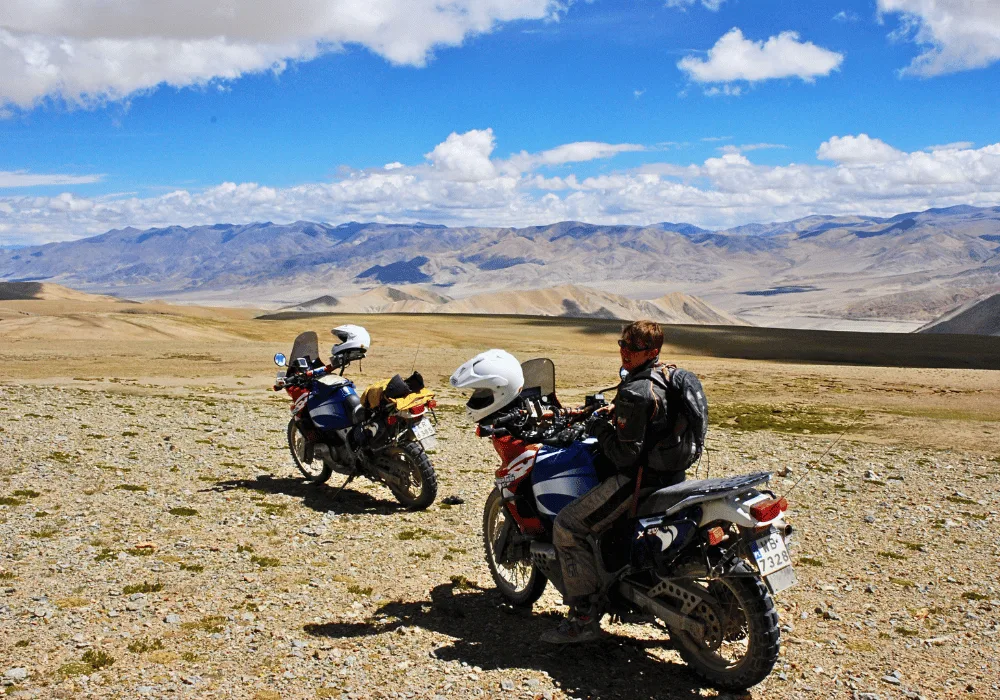
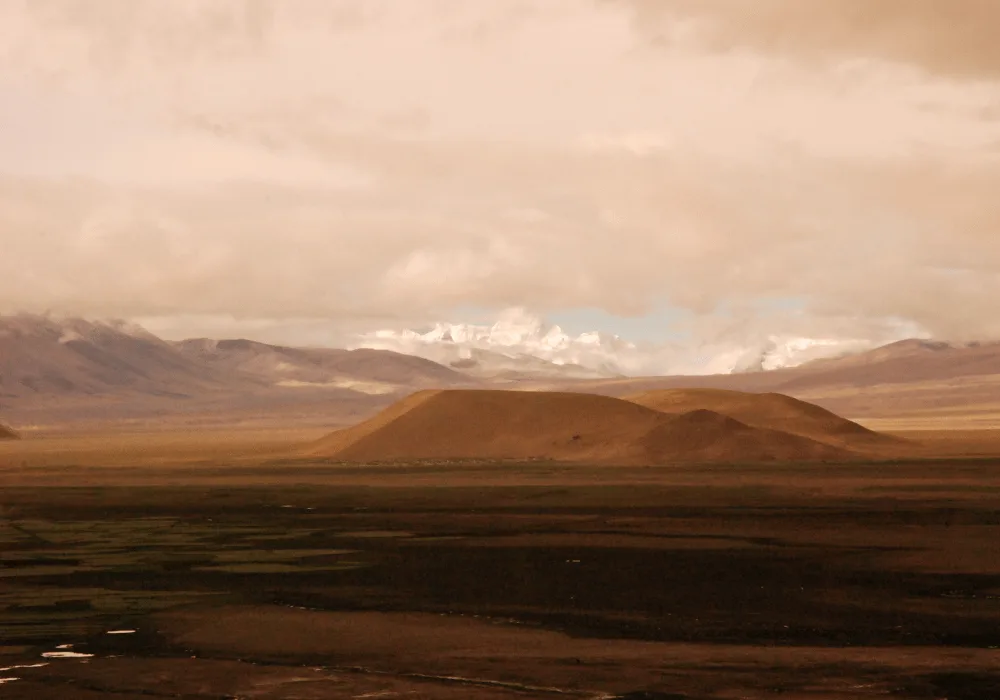
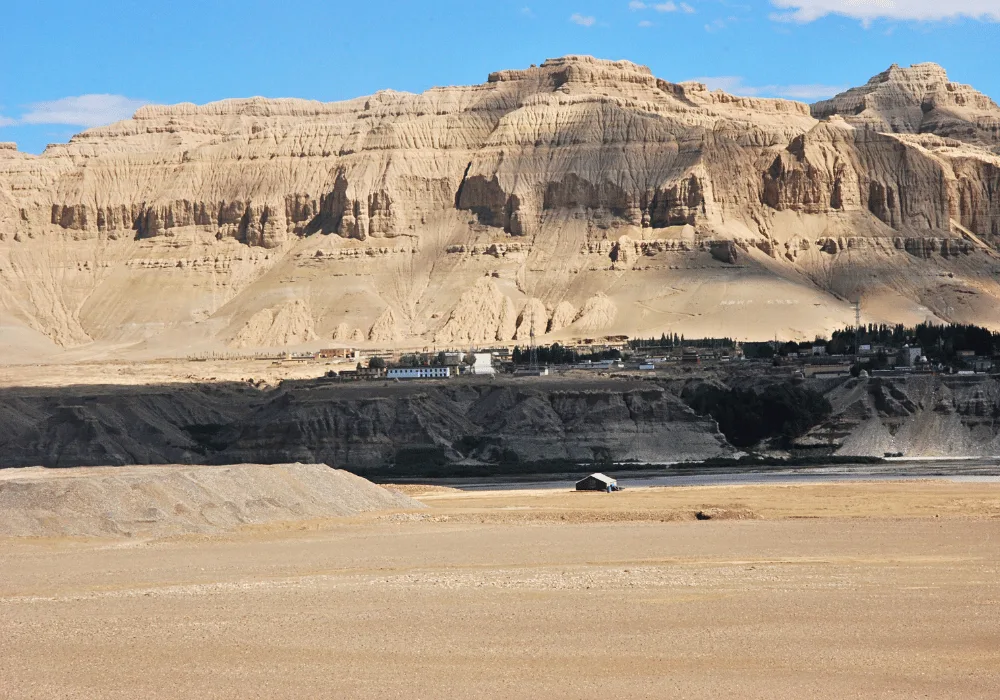
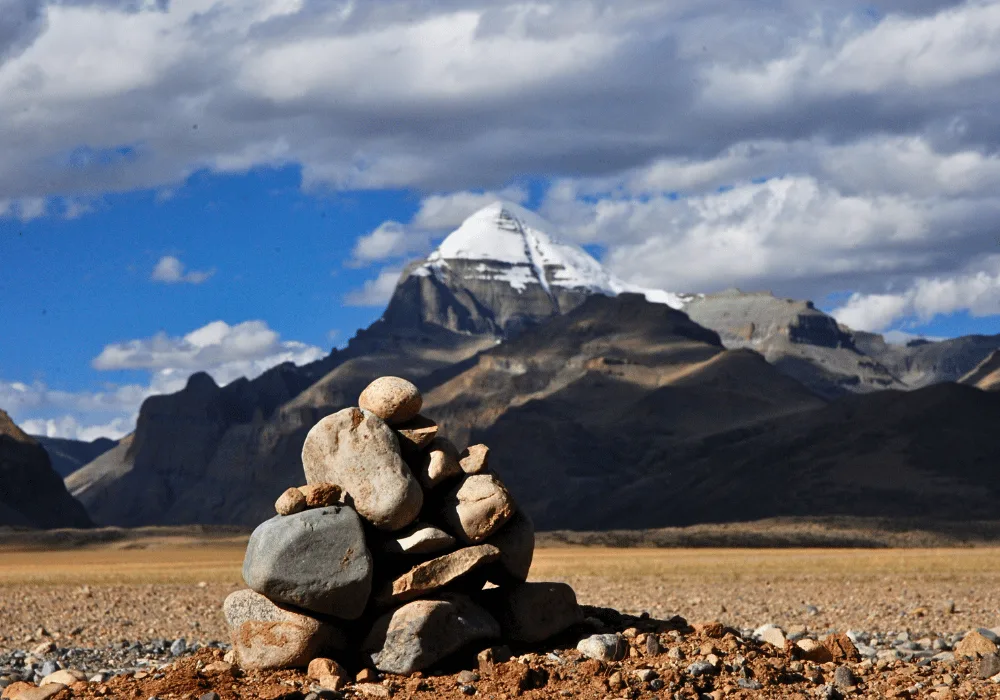
China Motorbike Journey – From Old Tingri to Zhangmu: Tropical Shock and a Farewell to Tibet
The road from Old Tingri to Zhangmu brought back memories of our early struggles in western Tibet. Detours were frequent — some sandy, others still under construction. Though we were on the famed Friendship Highway, parts of it were still being paved, so the traffic was sparse but required constant attention. Thankfully, the difficulties weren’t nearly as extreme as the ones we’d faced around Zada.
This section reminded us that a China motorbike journey isn’t all about smooth tarmac. We welcomed the return to challenging terrain. One of the passes we crossed exceeded 5,000 meters, but despite the lack of asphalt, it posed no serious threat. The visibility was poor, yet we managed to catch a glimpse of Shishapangma—one of the world’s 8,000ers—peeking through the clouds. The main Himalayan ridge, however, remained hidden.
Tropical Climate Shock – Are We Still in Tibet?
After passing Nyalam, the scenery changed dramatically. This was the second major climate shock of our entire journey — the first being on the Armenian-Iranian border. Without any mountain pass, the landscape around us turned intensely green. We had entered dense, tropical jungle.
Steep slopes surrounded us, waterfalls cascaded down beside the road, and fast-flowing streams cut across our path. We traversed muddy landslides and rocky sections where stone avalanches had previously blocked the road. In two places, we just barely managed to get through where landslides had closed the road. It felt like we had crossed into Southeast Asia, not remained within the Tibetan Plateau.
Final Push Through Jungle Chaos
The last three kilometers before Zhangmu tested us one last time. The road was still under construction — full of stones, mud, and overflowing water. Dozens of cars and trucks were completely stuck — some had been waiting there for over eight hours. Surprisingly, we were allowed to continue. Carefully navigating the final slippery stretch, teetering above deep ravines, we finally reached the town — soaked, exhausted, but relieved.
Zhangmu itself didn’t offer much charm. It lacked any sense of Tibetan spirit. It felt more like a melting pot — Nepalese, Chinese, and Tibetans living off cross-border trade. The Friendship Bridge over the Bhote Kosi River buzzed with life. Thousands of people and trucks moved goods across the border each day.
China Motorbike Journey – Final Rest and Farewell to Tibet
We crossed paths with several organized tourist groups traveling from Lhasa to Kathmandu. We had half a day to rest, so Jurek got to work prepping our bikes for lower altitudes. He removed the Dynojets that had helped us breathe at over 5,000 meters — they wouldn’t be needed in Nepal.
He wasn’t alone for long. Álvaro, a Spanish rider and vintage motorcycle collector, joined in. With his help, the tuning went much faster — even though they worked until nearly 1 a.m. I spent that time chatting in Spanish with Beatriz, his wife. Lovely people.
There’s a chance we might see them again in Ladakh, where they plan to head on their Royal Enfields. For us, Zhangmu marked the end of our Tibetan chapter. Crossing the border into Nepal was not just a change of country — it was the symbolic beginning of a whole new leg in our incredible journey.
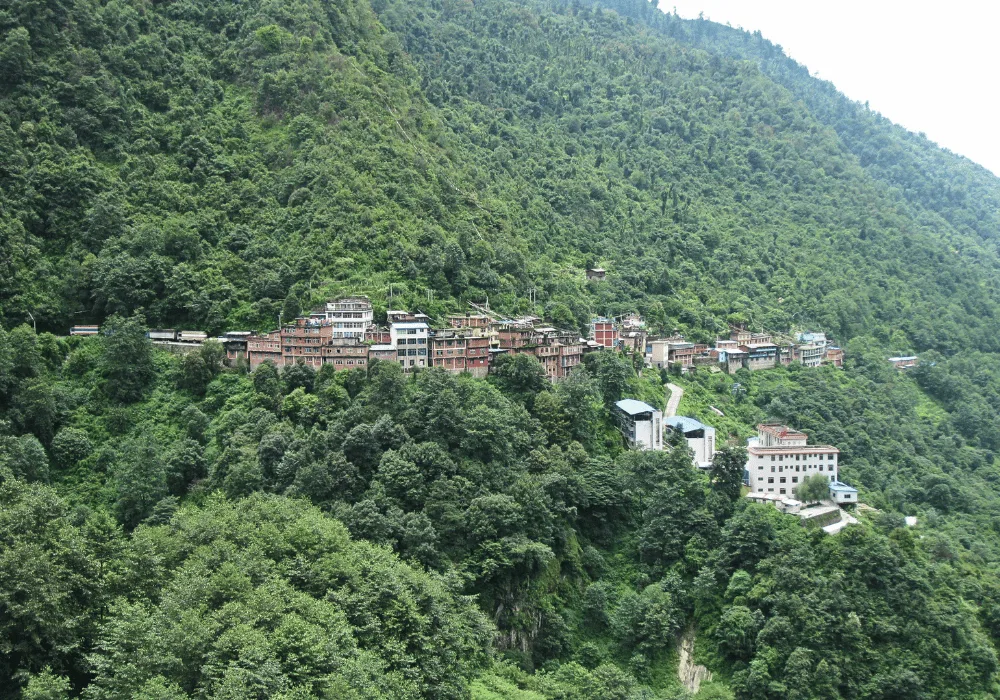
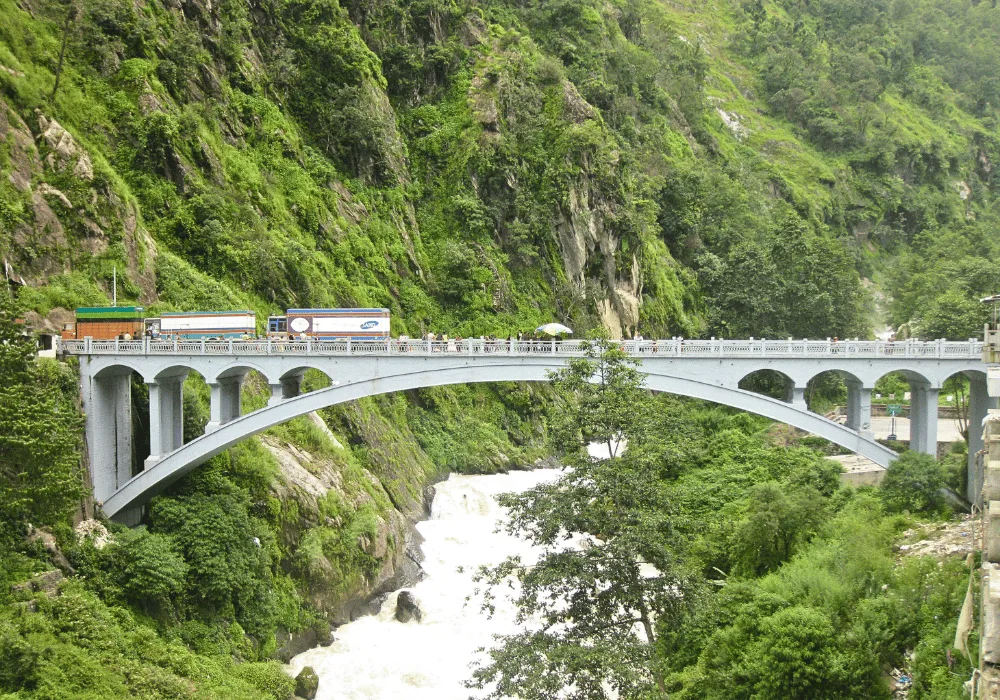
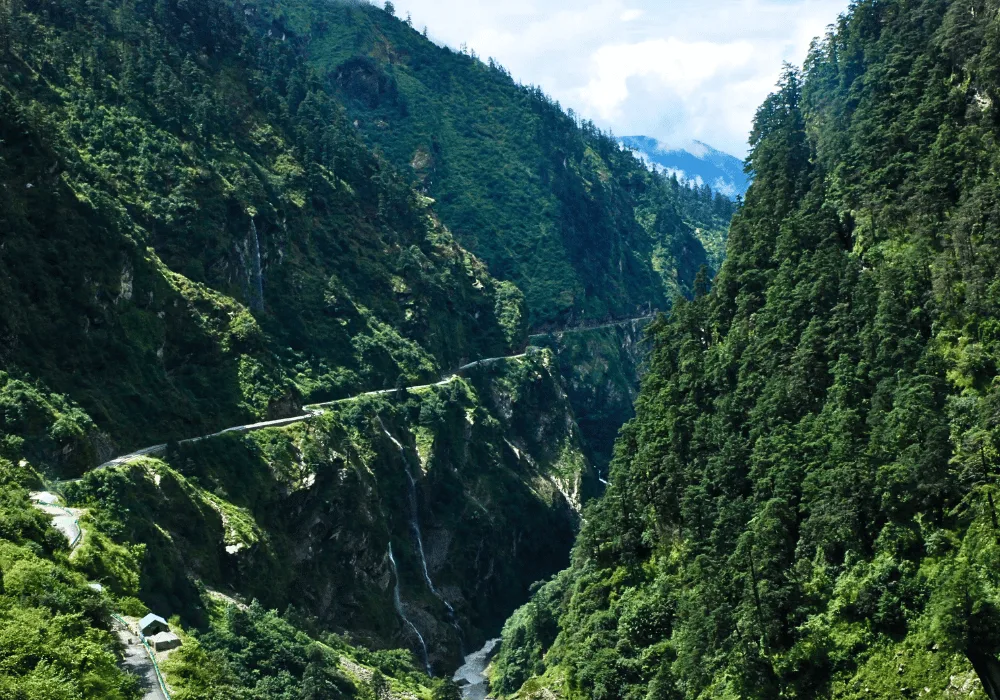
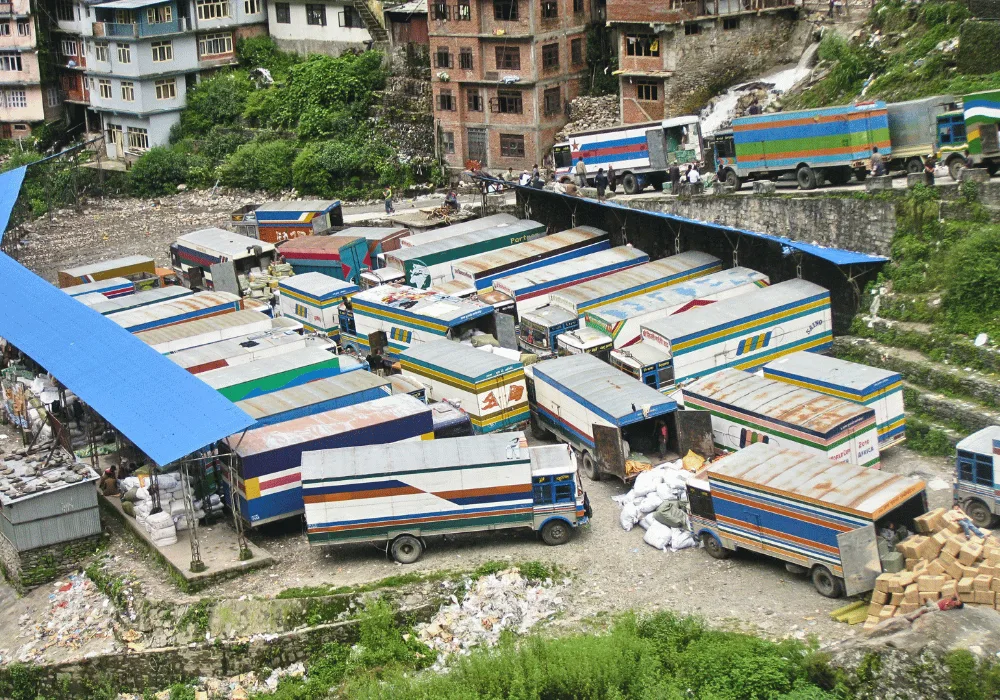
Ciąg dalszy nastąpi…
Dołącz do nas w tej niesamowitej podróży z Polski do Indii. Raz lub dwa razy w miesiącu możesz się spodziewać publikacji kolejnej części naszej przygody. Dzięki temu poczujesz magię tamtych dni, odkryjesz piękno odwiedzonych miejsc i przeżyć wraz z nami wszystkie te niezwykłe chwile. Każdy wpis to nie tylko opowieść o przygodach, ale także o wyzwaniach, które napotkaliśmy na naszej drodze, o ludziach, których poznaliśmy i o kulturach, które mieliśmy szansę zgłębić.
Świat się zmienia, ale wspomnienia z naszych podróży pozostają wieczne. To, co przeżyliśmy, ukształtowało nas i wzbogaciło nasze życie o niesamowite doświadczenia, którymi chcemy się z Tobą podzielić. Każdy odcinek naszej podróży będzie dla Ciebie możliwością przeniesienia się w czasie i przestrzeni, do miejsc pełnych przygód, niespodzianek i pięknych krajobrazów.
Zapraszamy Cię do aktywnego uczestnictwa w tej podróży. Czekamy na Twoje komentarze i refleksje, a może i własne opowieści z podróży! Twoja historia może być inspiracją dla nas i dla innych czytelników. Podziel się z nami swoimi doświadczeniami, spostrzeżeniami i pytaniami. Wspólnie stworzymy społeczność pasjonatów podróży motocyklowych, gotowych dzielić się wiedzą i wspomnieniami. 🙂
Zobacz także
Poznaj wszystkie etapy naszej historycznej wyprawy motocyklowej z Polski do Indii. Czytaj więcej o Motocyklowej Wyprawie do Indii z Aleksandrą Trzaskowską.


Newsletter subscribers get more!
Join MotoBirds Soaring Newsletter and don't miss any important content, gear tests, travel inspirations and newest offers in the future! We'll also let you know about fresh publications on our blog.



